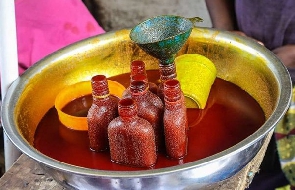 FDA cautions public on purchase of palm oil due to adulteration of product
FDA cautions public on purchase of palm oil due to adulteration of product
The Food and Drugs Authority (FDA) has cautioned the public to be vigilant when buying palm oil due to concerns raised about adulteration of the product.
The Deputy Chief Executive Officer of the FDA, Roderick Daddey-Adjei, explained that some traders are still using the banned 'Sudan four dye’ to adulterate palm oil products on the market, a situation that poses a serious public health risk to consumers.
In light of this, GhanaWeb gives a breakdown of what Sudan four dye is and its effects on human health
What is Sudan four dye
According to the Food and Drugs Authority, the Sudan Four dye is a chemical used in the production of textiles, leather, plastics, papers, hair, mineral oils, waxes, and cosmetics to impact colour.
It is harmful to humans and not advisable to be used as a food additive or enhancer due to its carcinogenicity and mutagenicity, as identified by the International Agency for Research on Cancer.
Why traders use it as additives in palm oil
The dye which is mostly used in palm oil by traders enhances the colour of the crude palm oil, which often loses its characteristic orange-red hue due to the use of poor-quality palm fruits and substandard production.
It is important to note that the usage of the Sudan Four dye as food additive is strongly banned by the Food and Drugs Authority and other international bodies.
Effects on health
Sudan Four dye is reported to have adverse effects on the health of individuals who consume it.
Some health issues associated with the consumption of the dye include migraine, severe allergies, hives, hyperactivity in children, and cancer.
Data from previous years
The Food and Drugs Authority disclosed that it recorded a 30% increase in adulterated palm oil during a Sudan Four dye test nationwide in 2021, compared to a 7.3% record in 2018.
This was after a routine market surveillance activity by the FDA.
In October 2023, palm oil samples by the FDA from major markets across the country, including 10 major markets in Greater Accra, revealed that 70 out of the 306 samples failed the test for Sudan IV dye.
According to the FDA, all regions except the Upper West Region had at least one sample from their markets test positive for Sudan IV dye, with Greater Accra recording the highest failure rate at 60.8%.
MAG/ ADG